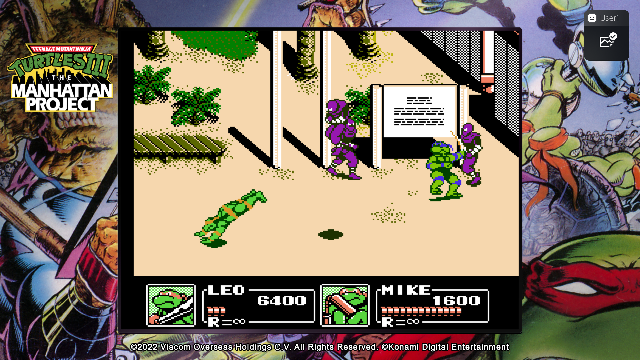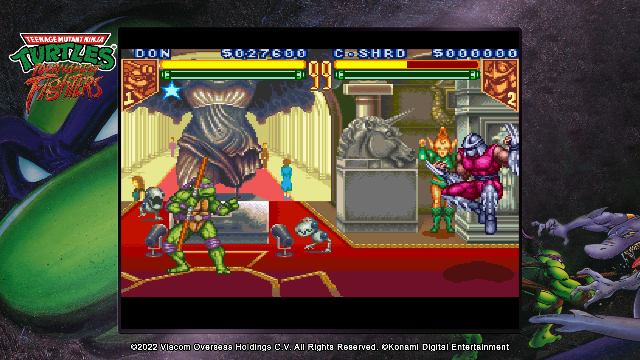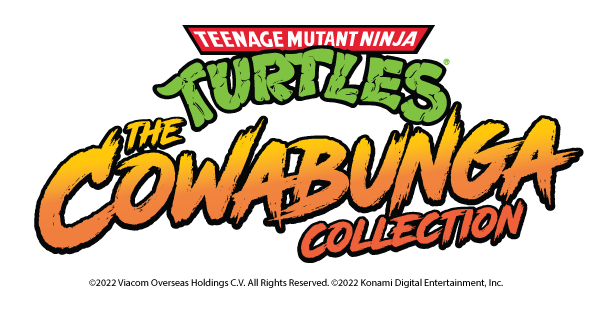Teenage Mutant Ninja Turtles: The Cowabunga Collection is the latest compilation of games from another era and unlike Capcom’s recent arcade collections, it focuses on one obvious theme. Bringing together the 13 TMNT games from the height of the 8 and 16-bit era, this is an odd mix of titles of varying entertainment value.
The most noteworthy inclusions are the two coin-op arcade games. Teenage Mutant Ninja Turtles and the sequel, Turtles in Time, are still beat ‘em up bangers. They’re shallow and fun with constant action for up to four players. Admittedly, in direct comparison to the recent and lovingly made sequel, Shredder’s Revenge, they definitely feel their age. Still, these arcade classics are a ton of mindless bashing fun, and the inclusion of online play is a big plus.
Teenage Mutant Ninja Turtles: The Cowabunga Collection Review — A Whole Shell’s Worth of Nostalgia
Beyond that, the 11 console games are pretty uneven. The four NES and three Game Boy games really haven’t aged well. The NES port of the first arcade game and Tournament Fighters pale in comparison to the SNES versions, for instance, and the gameplay on all these early 8-bit titles feels incredibly clunky. It’s fun to see the Game Boy games blown up on the big screen, but it also glaringly shows off the graphic and memory limitations of the system.
That said, if you grew up with these versions, the flood of nostalgia will still be immense. On the SNES and Genesis side, things are considerably brighter. The SNES port of Turtles in Time is especially impressive in its fidelity to the source material and even has some improvements, like boss health bars. The Genesis game, the Hyperstone Heist, feels a lot like a retooled remix of Turtles in Time, but also looks and plays very well. That said, between the four arcade-style games, there isn’t a lot in the way of gameplay variation.

This collection also vividly displays the era when developers made completely different games for different systems. While both versions of Tournament Fighters are essentially Street Fighter-like 2D fighters, the SNES version is completely different from the Genesis one. Different characters, different plots, different levels and gameplay. The Genesis version has Casey Jones and April, for instance, while the SNES version (which has a larger roster) has Shredder. These fighters both hold up remarkably well.
The Hyperstone Heist and SNES version of Tournament Fighters also support online play for two players, though all the multiplayer-centric games here support local multiplayer for two to four. There’s the Turtle’s Lair included, which is essentially a kind of virtual museum for the collection. Here you’ll find a variety of things like tons of concept art, box art, manuals, strategy guides, music, and even still shots of the various shows and comics.
The Lair is ultimately a bit disappointing, though. More depth beyond just animation still frames and comic book covers, for instance, would have be nice. While the legal rights would probably have been a nightmare, including some episodes and issues in full would have really made it feel more complete.
Finally, each title has a sort of cheats/mod menu that varies from game to game. Most of them offer the ability to turn on a god mode and select the starting level. Many of the NES and Game Boy games have an option to turn off flickering and slowdown (the ports are very accurate to the source material), along with some other fun ways to alter things. There’s even the ability to rewind during play, which is always a welcome option in classic games.
Teenage Mutant Ninja Turtles: The Cowabunga Collection Review — The Bottom Line

Pros
- A very complete collection with 13 games across five platforms.
- The TMNT arcade and fighting games are still remarkably fun.
- Online play for several games and some nice cheat options.
- Lots of concept and sketch art for fans of that sort of thing.
Cons
- A lot of sameness in the gameplay.
- NES and GB games are really rough to play in modern times.
- Turtle’s Lair museum is a bit light on content.
Teenage Mutant Ninja Turtles: The Cowabunga Collection is likely only going to appeal to those who grew up with these titles or possibly those just really into the Turtles. It’s a very complete collection showing the evolution of the series through multiple platforms, and some of the games remain fun, but overall, this is more of an historical curiosity than a classic must-play.
[Note: Konami provided the copy of Teenage Mutant Ninja Turtles: The Cowabunga Collection used for this review.]







Published: Sep 1, 2022 07:49 am